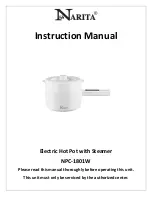
oil supply system. (See Figs, 23, 24, & 25 ).
At the point where the oil line enters the building, the
oil line must be fitted with an approved remote act-
ing fire valve, which meets the requirements of B.S.
5410 : Part 1, fitted with the appropriate length of
capillary. The heat sensing phial of the fire valve
must be fitted to the clip provided in the burner com-
partment. It is absolutely essential that the fire valve
is located externally and is as close as possible to
the appliance. For existing installations where the
oil supply are built into the structure internally, the
remote acting fire valve should be fitted where the
oil supply line is first exposed internally. This type of
layout is not recommended for new installations.
When gravity feed is used (the most common) the
minimum head should not be below 1 meter (3’3”)
and the maximum head should not exceed 6.5
meters (21’ 3”).
NOTE:
The pump is factory set for a single pipe
installation.
The oil line is to be connected to the flexible oil hose
attached to the burner. Push the flexible oil hose
through the grommet on the left hand side of the
appliance.
17
SINGLE PIPE SUPPLY SYSTEM:
BOTTOM OF OIL STORAGE TANK ABOVE
BURNER
(See fig.23 )
Single pipe supply system:
Tanks servicing this
appliance by means of a single pipe need to be posi-
tioned so that they will apply the minimum head
required 1 meter (3’ 3”) of oil to the burner when the
fuel level is at its lowest point.
Refer to B.S. 5410 to calculate the additional head
requirement relating to pipe length and size.
Fig.23
TWO PIPE SUPPLY SYSTEM:
(See fig.24)
BOTTOM OF OIL STORAGE TANK BELOW
OR LEVEL WITH BURNER
gravity feed to the burner can be maintained a two
pipe oil supply system may be adopted. (See fig.
24). The non-return valve in the supply line of the
two pipe system is required to prevent oil running
back from the burner and unpriming the oil pump.
The non-return valve in the return line is only
required if the top of the tank is above the burner. Its
purpose is to prevent oil running back through the
burner during maintenance.
Fig.24
SINGLE PIPE SYSTEM:
WITH
DE-AERATION DEVICE BOTTOM OF
OIL STORAGE TANK BELOW OR LEVEL
WITH BURNER.
(see fig. 25):
This system can be used where the tank base is
below the level at which gravity feed to the burner
can be maintained and the burner incorporates an
oil pump. The chamber is fitted close to the burner
and is linked to the tank by a single pipe, thus sav-
ing the return pipe required by the two pipe system
as described previously. Any air in the oil brought up
from the tank is bled off in the de-aeration chamber.
De-aeration chambers must always be installed
externally to buildings because they emit small
quantities of vapour. The chamber is connected to
the oil pump in the burner of the appliance by a nor-
mal two pipe loop.
These requirements are fully explained within the
following documents:
*
B.S. 5410: Part 1: Code of Practice for Oil
firing installations up to 45 kW output capac-
ity for space heating and hot water supply
purposes.
*
OFTEC - Technical information Book Three.
Installation requirements for oil fired boiler
and oil storage tanks.
*
The Building Regulations Part J: Ireland Part
F Section 4 Scotland and Part L Northern
Ireland.
*
The Building Regulations Part J: England &
Wales.
If the tank base is below the level at which the







































